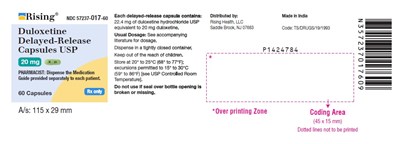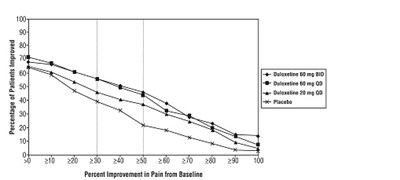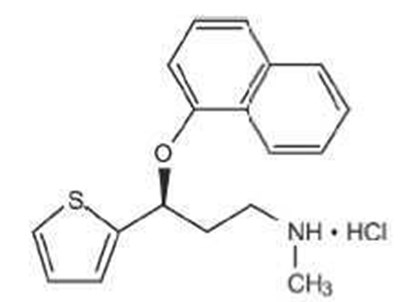Product Images Duloxetine
View Photos of Packaging, Labels & Appearance
- Figure 1: Kaplan-Meier Estimation of Cumulative Proportion of Patients with Relapse (MDD Study 5) - duloxetine fig1
- PACKAGE LABEL-PRINCIPAL DISPLAY PANEL - 20 mg (60 Capsules Bottle) - duloxetine fig10
- PACKAGE LABEL-PRINCIPAL DISPLAY PANEL - 30 mg (30 Capsules Bottle) - duloxetine fig11
- PACKAGE LABEL-PRINCIPAL DISPLAY PANEL - 60 mg (30 Capsules Bottle) - duloxetine fig12
- Figure-2 - duloxetine fig2
- Figure-3 - duloxetine fig3
- Figure 4: Percentage of DPNP Adult Patients Achieving Various Levels of Pain Relief as Measured by 24-Hour Average Pain Severity (Study DPNP-2) - duloxetine fig4
- Figure 5 - duloxetine fig5
- Figure 6 - duloxetine fig6
- Figure 7 - duloxetine fig7
- Figure 8 - duloxetine fig8
- Figure 10: Percentage of Adult Patients with OA Achieving Various Levels of Pain Relief as Measured by 24-Hour Average Pain Severity (Study OA-1) - duloxetine fig9
- Chemical Structure - duloxetine str
Product Label Images
The following 13 images provide visual information about the product associated with Duloxetine NDC 57237-017 by Rising Pharma Holdings, Inc., such as packaging, labeling, and the appearance of the drug itself. This resource could be helpful for medical professionals, pharmacists, and patients seeking to verify medication information and ensure they have the correct product.
Figure 1: Kaplan-Meier Estimation of Cumulative Proportion of Patients with Relapse (MDD Study 5) - duloxetine fig1
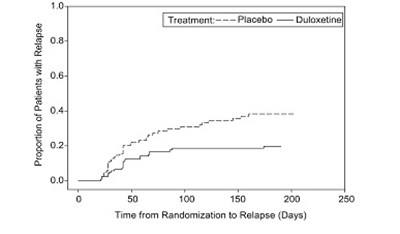
PACKAGE LABEL-PRINCIPAL DISPLAY PANEL - 30 mg (30 Capsules Bottle) - duloxetine fig11
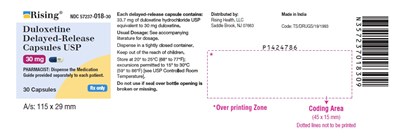
Rising® wocs72s7-018.30 is a medication that comes in delayed-release capsules containing 33.7 mg of duloxetine hydrochloride USP, equivalent to 30 mg duloxetine. It is important to follow the usual dosage indicated in the accompanying literature, and to dispense it in a tightly closed container and keep it out of the reach of children. The medication should be stored at a temperature between 20°C to 25°C, with excursions permitted to 16°C to 30°C. It is not to be used if the seal over the bottle is broken or missing. This medication is distributed by Rising Health, made in India and manufactured by LG. The product code is TS/DRUGS/19/1983 w."*
PACKAGE LABEL-PRINCIPAL DISPLAY PANEL - 60 mg (30 Capsules Bottle) - duloxetine fig12
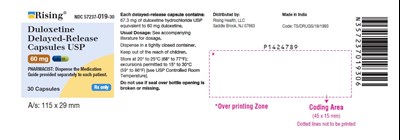
This is a product description for Rising® brand delayed-release capsules USP containing Duloxetine hydrochloride USP. The capsules are packaged in a bottle containing 30 capsules and the usual dosage is printed in the accompanying literature. The medication guide should be provided to each patient by the pharmacist. The product must be stored in a tightly closed container and kept out of the reach of children. The bottle should be stored at a temperature ranging from 20 to 25°C. The print indicates that it was distributed by Rising Health, LLC from Saddle Brook, NJ and was made in India.*
Figure 4: Percentage of DPNP Adult Patients Achieving Various Levels of Pain Relief as Measured by 24-Hour Average Pain Severity (Study DPNP-2) - duloxetine fig4
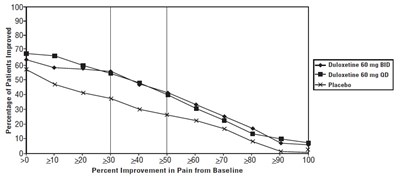
The text appears to be a graph displaying the percentage of patients who improved while taking Duloxetine 60 mg BID, Duloxetine 60 mg QD, or Placebo, in relation to the percent improvement in pain from baseline. Unfortunately, a description of the graph cannot be provided as there is no accompanying image or further context given.*
Figure 5 - duloxetine fig5
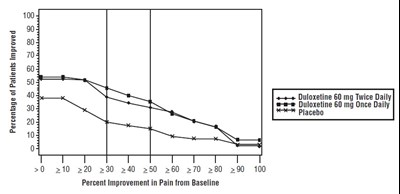
The text describes a graph showing the percentage of patients' improvement in pain and the percent improvement in pain from a baseline. The graph also includes the names of medications being compared, including Duloxetine and Placeho.*
Figure 6 - duloxetine fig6
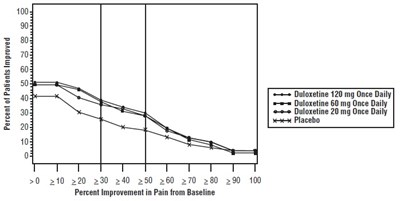
The text appears to be an image or a table with numerical values and medication dosages, and a graph showing percent improvement in pain from baseline. The medications mentioned are duloxetine at doses of 20 mg, 60 mg, and 120 mg taken once daily. The graph shows the percentage of patients who experienced pain reduction at various levels, compared to a placebo.*
Figure 7 - duloxetine fig7
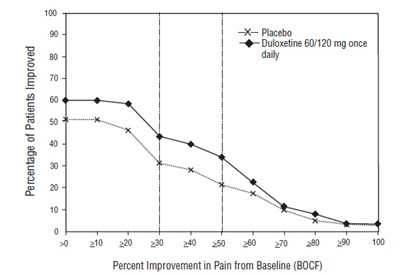
The graph shows the comparison between a placebo and Duloxetine at 60/120mg once daily on the percentage of patients improved, based on the percent improvement in pain from baseline (BOCF). The X-axis represents the percent improvement while the Y-axis represents the number of patients. There is a significant improvement in the number of patients on Duloxetine compared to the placebo.*
Figure 8 - duloxetine fig8
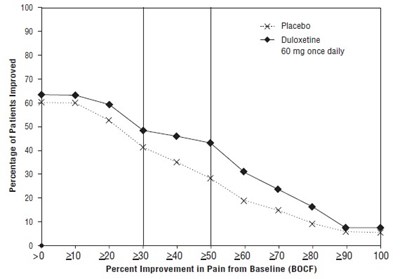
This appears to be a graph or chart that shows the percentage of patients who improved after taking either a placebo or Duloxetine at a dosage of 60 mg once daily. The x-axis shows the percent improvement in pain from the baseline, while the y-axis shows the number of patients. The data points on the chart suggest that more patients improved after taking Duloxetine than those who took the placebo.*
Figure 10: Percentage of Adult Patients with OA Achieving Various Levels of Pain Relief as Measured by 24-Hour Average Pain Severity (Study OA-1) - duloxetine fig9
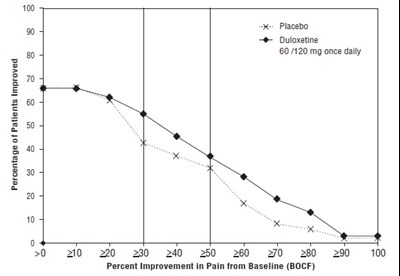
This text appears to be a graph or chart related to the effectiveness of a medication called "Placeto & Dulowetine" in treating pain. It shows the percentage improvement in pain from baseline over time for patients who took 60/120 mg of the medication once daily. Without more context or information, it is difficult to provide further details or conclusions.*
* The product label images have been analyzed using a combination of traditional computing and machine learning techniques. It should be noted that the descriptions provided may not be entirely accurate as they are experimental in nature. Use the information in this page at your own discretion and risk.
